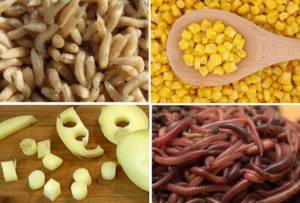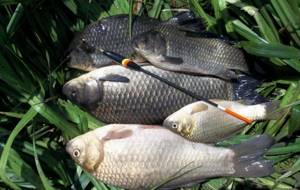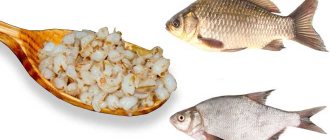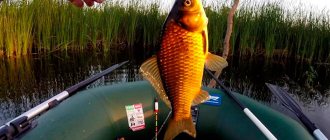Best time to fish
The active biting time of large crucian carp depends on several factors, among which the main ones are the period of the year, time of day and ambient temperature. Knowledge of these features allows you to accurately determine the most profitable time for fishing, and with this, achieve a record catch.
The traditional period for catching large specimens is considered to be early spring. At this time, the fish actively gain weight before spawning, which is why crucian carp is able to swallow almost any amount of food. In this case, with the correct equipment and approach to fishing, the “little things” have practically no chance of getting to the bait, since the big fish almost always wins the competition. The activity of large crucian carp decreases sharply during spawning; this happens as soon as the water warms up to a constant temperature of approximately +15°C.
Find out when is the best time to catch crucian carp.
Biting activity for large individuals intensifies in early summer, several weeks after spawning. The best time for fishing is considered to be early morning and late evening. Carp fish have a hard time withstanding the heat, so during this period they stay closer to the bottom of the pond or lake. If the average water temperature in a reservoir does not exceed +18…+20°C, crucian carp can be caught at any time of the day. Moreover, it will peck most actively in calm and cloudy weather, and especially if there is light rain in this case.

In autumn, underwater inhabitants begin to gain weight for a safe winter, so after the first cold snap, the crucian carp will be biting to the maximum. At this time, it can be caught at absolutely any time of the day, so almost every fisherman has a chance of catching a trophy specimen.
The favorable period lasts until the first frost, then the fish goes to the bottom and in most cases goes into hibernation.
Habitats
Crucian carp is an unpretentious and very tenacious fish. He is able not only to exist, but also to feel comfortable where others simply cannot survive. Any fisherman knows about the endurance of this species. If you put a crucian carp in a basket with wet grass, it will live there for at least a day. In reservoirs overgrown with duckweed and underwater vegetation, where there is a lack of oxygen in the water, this fish feels great, and even reproduces stably. The thing is that the crucian carp was able to adapt. It breathes not only through its gills, but throughout its entire body. That’s why crucian carp are found in dugouts, peat bogs, and quarries. Even if these reservoirs freeze completely in winter, the fish survive. Crucian carp is capable of burrowing into mud to a depth of 70 cm, or even more. But it still doesn’t like cold water, so you won’t find this species in mountain lakes. So, before telling you what you need to use to catch crucian carp, you need to dwell in more detail on the features of the reservoirs in which it lives. This is important because both the choice of gear and bait depend on it.
Where to catch large crucian carp
Representatives of the carp family are considered traditional inhabitants of freshwater reservoirs located in temperate climates. That is why an angler can easily find them in almost any lake, river, etc. However, it is not possible to catch a really large crucian carp in every place; for this, special conditions and microclimate must be formed.
Important! Crucian carp is not found in mountain reservoirs.
Its traditional habitat is considered to be reservoirs located in the lowlands or on the plain, and especially in swampy areas. The main one is the size of the reservoir, because only in a large river or lake is the necessary food supply and living space formed. In addition, depth is an important factor.
For the successful growth and development of large specimens, the water layer from the bottom to the surface must be at least 3–4 m, so you need to find the optimal place long before you go fishing. In this case, such fish most often live:
- at a distance of 10–15 m from the shore;
- in bays with dense vegetation;
- near underwater holes and edges;
- near flooded trees or snags.

Types of crucian carp and their description

Before thoroughly studying how and what to catch crucian carp with, it doesn’t hurt to find out what kind of fish it is. It is interesting that in nature there are at least two subspecies of crucian carp - the “round” golden one and the silver one with an oblong body. Light crucian carp is more common. The difference between these two types lies in the name. The golden carp has a corresponding shade of scales. His body is more close to a spherical shape. The back rises like an arch. The goldfish has light scales. The body is oblong. And the caudal fin has a clear bifurcation.
It will be even more interesting to know that, apart from external dissimilarity, in other respects they are the same species. In addition, both subspecies easily interbreed and produce viable offspring. It is curious that, according to scientists, the overwhelming majority of crucian carp existing today are silverfish, and the majority (and according to some ichthyologists, all of them) are females. Their eggs are fertilized by males during spawning. Their color is golden. But that's not all. For a long time they could not understand how crucian carp reproduces in reservoirs where there is no golden subspecies. It turned out that their eggs can be fertilized by tench. At the same time, ordinary crucian carp will develop from it. There are also fast-growing hybrids of crucian carp and crucian carp.
What to feed to catch large ones among small ones
When catching only large fish, you need to pay the necessary attention to feeding. It should attract only the necessary specimens, therefore it should consist of fairly large particles that small fish cannot swallow. Often, whole boiled grains of millet, peas or pearl barley are used for this, with the addition of a few drops of anise oil (per 250 g). As a simpler alternative, use rye crackers, cut into small cubes (at least 0.5x0.5 cm in size).

Lure for crucian carp
In purely crucian carp reservoirs, where the number of fish is already large, there is no point in complementary feeding. The crucian carp will already regularly grab the bait due to the fact that the food supply in such floodplain swamps and quarries is low. Complementary feeding is carried out only when the fish are absent-minded. These are bodies of water such as rivers and large flowing lakes.
Having decided what to use to catch large crucian carp, you need to take more bait. This fish is often fed with the same thing that is strung on the hook. Crucian carp is very sensitive to odors. When preparing a bait mixture for him, do not forget about this. They lure fish to the fishing site with various cereals. It can be rolled oats, semolina, wheat, corn. Crucian carp also responds well to various crackers. But he especially loves pearl barley. As a rule, several components are mixed at once, not forgetting about animal bait. You can use small maggots. It will move in the water and crawl along the bottom, which the fish will undoubtedly like.
What do you use to catch big crucian carp and what scent do you use to lure it to a baited hook? Sunflower or anise oil is often used as a flavoring. Although each angler will have his own opinion on this matter. In fact, there are many flavors that crucian carp like. Some of them, such as the drug Corvalol, are completely original.
What is the best way to catch large crucian carp?
Similar requirements (as for bait) are put forward for bait; its shape and volume should attract exclusively large crucian carp . This rule applies regardless of the type of bait. That is why worms, bloodworms and all kinds of cereals must be large in size (about 0.5–1 cm in diameter).
We advise you to learn how to prepare dough for catching crucian carp.
In spring and autumn, fish bite best on animal baits, while bloodworms, maggots and worms (dung and earthworms) are considered traditional. In summer, crucian carp are most interested in plant foods; in this case, they use boiled peas, corn, pearl barley or pieces of boiled potatoes. At the same time, it is recommended to stock up on all types of bait when traveling, because crucian carp is an unpredictable fish, so it is very difficult to predict its tastes for a good bite.

Making effective baits with your own hands
You can successfully make bait for crucian carp yourself.
Effective options are:
Mastyrka
The process of preparing mastyrka
For production you need:
- peas - 2 tablespoons;
- oatmeal flakes – 1 tablespoon;
- garlic – 1 – 2 cloves;
- vegetable oil – 1 tablespoon;
- water – 250 milliliters.
Pour boiling water over the peas, leave for 3-4 hours, then mix with oatmeal and cook for 10 minutes. Next, take a frying pan, pour oil into it, fry the prepared mixture for 3 minutes and put everything in the refrigerator.
Rules of application:
- 1 – 2 hours before fishing, remove the mastyrka from the refrigerator.
- Add grated garlic to it.
- Roll into balls.
- Before casting, place it on the hook so that the entire tip is covered.
Mastyrka is successfully used in winter and autumn, especially at depth.
Sandwich
You will need several different larvae, for example, a mosquito and a fly.
Tip: a grasshopper and a Colorado potato beetle are used successfully to make a sandwich.
Rules of use:
- Place a mosquito larva on the hook, then a fly.
- Throw the tackle so that the bait is completely hidden under water.
The sandwich is best used in low currents during the hot season.

Storm brod made from worms and maggots
Hominy
Mamalyga should be used from mid-spring to early autumn in reservoirs with moderate currents.
It is a porridge made according to a special recipe.
To prepare you need to take:
- corn flour - 3 tablespoons;
- wheat flour - 1 tablespoon.
Mix the flour, then gradually pour warm water into the mixture to form a thick dough.
Next, wrap it in cling film and place it in boiling water for 30 minutes. At the end of cooking, remove and, without removing the film, leave to cool.
Rules of use:
- On the shore, remove the film.
- Pinch off a piece of 2 - 4 centimeters.
- Pass the hook point through the middle.
- Cast.
Hominy should be used from mid-spring to early autumn in reservoirs with moderate currents.
Mixes
It is better to fish for mixes in late spring and summer, mainly near the shore.
You need to take:
- black bread – 150 – grams;
- boiled potatoes - 1 piece;
- honey – 1 teaspoon.
Cut off the crusts from the bread, mix the crumb with finely chopped potatoes, add melted honey.
Rules of application:
- At the pond, disconnect a piece of 2 - 3 centimeters from the mix.
- Mash it in your hand.
- Thread through the hook.
- Throw the tackle so that the bait goes under the water.
It is better to fish for mixes in late spring and summer, mainly near the shore.
To successfully catch crucian carp:
- Study the body of water, its flow speed, and the nature of the coastal zone in advance.
- Check the weather forecast for your planned fishing day.
- Prepare bait depending on the season and the specifics of the reservoir.
- Just in case, take some rye bread with you (sometimes the crucian carp starts to actively peck at it).
- String and cast strictly according to all recommendations.
Fishing technique and tactics
The basics of technique and tactics for catching large crucian carp are quite simple, but often even experienced fishermen are unable to follow all the recommendations. That is why they begin to study all the intricacies of catching such fish long before the start of the season.
Often, in order to be successful and achieve an excellent catch, you need to complete the following sequential steps:
- Determine the optimal location. This stage involves identifying the so-called “carp trails” - migration and hunting sites. In most cases, these are open areas near snags and thickets with various holes and edges. They begin this step long before the main trip to the reservoir.
- Groundbait . On the territory of 1–2 or more advantageous areas of the reservoir, bait should be thrown approximately 30–60 minutes before throwing gear. To do this, use about 250–500 g of specialized food per area of future fishing, so there should always be a lot of bait.
- Throwing basic gear. This is the final stage, followed by proper hooking.
Did you know? The rarest crucian carp in the world is considered to be the red one. Its natural habitat is rapidly decreasing, so the species is protected by the Red Book and is included in the list of endangered species.
When fishing, you should also observe some tactical features.
To use all the gear, as well as the time spent, with maximum benefit, you should:
- maintain maximum silence: crucian carp are quite shy, so on the shore it is forbidden to speak loudly and create other acoustic interference;
- choose reservoirs away from large cities and industrial enterprises;
- before going for a large fish, be sure to practice catching smaller specimens, otherwise it will not be easy to get a large specimen;
- choose fishing areas at a distance of at least 10 m from the shore;
- move out to the reservoir only in the early morning and evening - natural periods of daily activity of fish.

crucian carp reservoirs
In almost any region of our country you can find reservoirs in which crucian carp live. But all of them are conventionally divided by fishermen into three groups, each of which has its own fundamental differences.
The first group includes small reservoirs with a poor food supply. Who is found here besides crucian carp? As a rule, there is no one. The most common example is floodplain swamps that freeze in winter. What is the best way to catch crucian carp here? Of course, on a float rod. The bait may vary. The crucian carp in such reservoirs is not particularly large, but there is a lot of it. Well, since there is little food in the swamps, crucians will readily be caught on a hook.

The second group includes reservoirs in which crucian carp live next to several other species of fish. Most often its neighbors are perch, roach, pike, and carp. Such a pond or river has a sufficient food supply. Due to fierce competition, there are fewer crucian carp here, but they are larger. This is explained by the fact that small individuals are quickly eaten by a voracious predator. They fish in such reservoirs with a float rod, and if the bottom is not too silted, then you can try fishing with a donk.
And the last, third group of reservoirs where you can catch crucian carp are rivers with a weak current. This also includes the mouth areas of large reservoirs. The crucian carp here will stay more in the backwaters. In such places the current is very weak, the food supply is rich, but there are also many predators. Pike perch can also be added to pike and perch. Crucian carp in such reservoirs are more mobile and larger, they even make seasonal migrations. They catch it with bottom and float rods, as well as with a feeder.
What to do if only small crucian carp bite
A bite from a small fish is the first sign of serious errors in preparation. Most often this is caused by choosing an unsuitable place, as well as throwing bait outside hunting areas and camps for large animals. To solve this problem, it is enough to re-cast the bait and also reconfigure the gear. “Hunting” for crucian carp is carried out only in places with depths of more than 3 m, and the main bait must be located almost near the very bottom.
You can drive away the “trifles” by replacing the bait. Quite often, during preparation, fishermen digest grains of cereals and legumes, so later in the reservoir they create a large muddy cloud, which attracts exclusively small crucian carp. In this case, only slightly undercooked bait will help save access to the reservoir.

If you still cannot get rid of small fish biting, you can solve the problem by changing the casting range of the bait . In this case, you should definitely use the following rule: large fish live only at maximum depth and distance from the shore. However, when fishing with float gear, this will not be possible, so in this case it is recommended to change the fishing location.
Among professional and amateur fishermen, large crucian carp is considered a real trophy. This type of fish can reach impressive sizes and weights, which in some cases can be astonishing. However, catching such fish is not always easy; this will require not only choosing the right body of water and the appropriate equipment, but also mastering the skills of properly hooking and landing the catch.
Choosing gear for catching crucian carp
In a river where there is no current, you should take a float tackle with a hook larger than number 6. And during the current, a feeder will work well if the depth does not reach more than 2 meters.
Tackle that is considered good in the eyes of a fisherman must meet basic requirements.
There are equipment:
- Classical;
- Specialized.
Classic rig is the simplest way of fishing. This includes fishing for:
- Elastic band;
- Spring
Specialized includes:
- Flywheel;
- Bologna;
- Match;
- Plug-in.
Below each of the fishing methods will be discussed in more detail.
Simple fly rod
Used over short distances. The positive aspect is the ease. The gear uses a fishing line with a minimum diameter and a float of up to 1 gram. Most effective in spring and autumn.
Long casting rod
- Bologna - used over long distances with a current. Used by experienced anglers in large areas. A special feature is the rod with a reel, which allows you to cast over long distances.
- Matchovaya – long casting without current. It is used in the summer, as at this time of year it is in demand due to its effectiveness.
Differences from other gear include:
- Cone-shaped coil;
- Large float;
- Short keel.
Feeder tackle
A feeder is a bottom fishing tackle that even a novice fisherman can assemble. Attention should be paid to the base, it should be dense and stable, basically these are 2 rods of the same size and one 3-4 times smaller, from the resulting materials you should build a slingshot, the sharp end of which will be in the water. To hear the fish bite, you can use bells that will give a signal in time.
Fishing with an elastic band
A type of bottom fishing rod that looks like a 50-meter piece of fishing line. The end of the fishing line should have several hooks and a weight, as well as a shock-absorbing part.
The advantage is:
- No breakage at the wrong moment;
- Easy to get catch;
- It’s clear when the fish start biting.
Let's celebrate! This type should be used only on rivers; in addition to crucian carp, it can catch pike and ide.
Spring fishing
Catching with a spring is simple, convenient and without extra costs. The positive aspects include a good catch compared to other species. It is used in ponds and lakes with minimal or no current.
The spring and hook are installed between the fishing line so that the invention does not float away into the mud or silt. Complementary food is stuck onto the spring itself so that the spring is not noticeable. When using the bait, the fish gets hooked on the spring and hooks on its own.
The bait should be thick so as not to crumble. Mostly it is a porridge made from any boiled cereals with milk.
Tackle Crucian killer
The appearance of the Killer resembles a mousetrap, where there is a feeder in the center of the structure, and nozzles along the edges. When a fish bites, it automatically hooks. Can be used at any time of the year and day.
The tackle consists of:
- The base, which is a dense fishing line;
- Hooks size 4,5,6;
- Leash;
- Sinker;
- Coil;
- A feeder into which the bait is placed.










